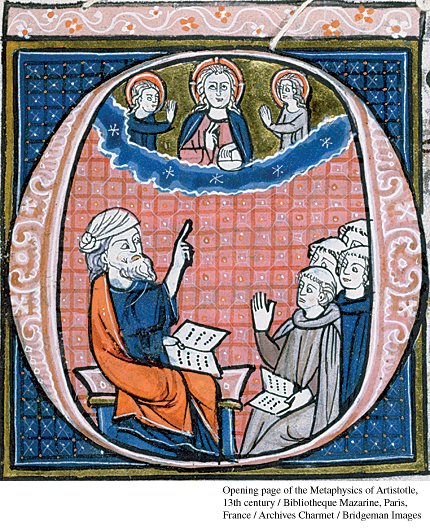Introduction for Chapter 12

TOWARD THE END of the thirteenth century, a Paris workshop produced an elegantly illustrated translation of some of Aristotle’s works. On the opening page of Aristotle’s Metaphysics, in the large O of the first word, omnes (“all”), an artist depicted Aristotle seated on a bench and pointing to the sky. Although Aristotle was a Greek who had lived before the time of Christ, the artist showed him instructing monks while he pointed to a sky dominated by Christ himself. In this way, the artist subtly but surely incorporated the pagan Aristotle into Christian belief and practice.
In the period from 1215 to 1340, Europeans at every level, from workshop artisans to kings and popes, thought that they could harmonize all ideas with Christianity, all aspects of this world with the next, and all of nature with revelation. Sometimes, as in the case of the illumination made for Aristotle’s treatise, the synthesis worked. But often it was forced, fragile, or elusive. Not everyone was willing to subordinate his or her beliefs to the tenets of Christianity; kings and popes argued, without resolution, about the limits of their power; and theologians fought over the place of reason in matters of faith. Discord continually threatened expectations of unity and harmony.
Medieval thinkers, writers, musicians, and artists attempted to reconcile faith and reason and to find the commonalities in the sacred and secular realms. At the level of philosophy, this quest led to a new method of inquiry and study known as scholasticism. Yet some scholastic thinkers pointed out cracks and disjunctions in the syntheses achieved.
To impose greater order and unity, kings and other rulers found new ways to extend their influence over their subjects. They used the tools of taxes, courts, and even representative institutions to control their realms. Popes issued new laws for Christians and established courts of inquisition to find and punish heretics (those who dissented from church teachings). Both secular and religious authorities at times persecuted Jews and lepers. Yet none of this prevented dissent, and rulers often did not gain all the power they wanted.
CHAPTER FOCUS In what areas of life did thirteenth-century Europeans try to find harmony and impose order, and how successful were these attempts?
From 1215 to 1340, the Empire weakened, the papacy asserted itself but was eventually forced to move out of Rome, and the Mongols challenged Christian rulers. Soon natural disasters—crop failures and famine—added to the tension.